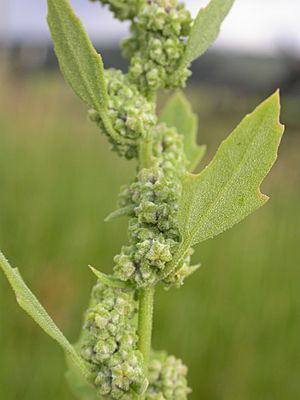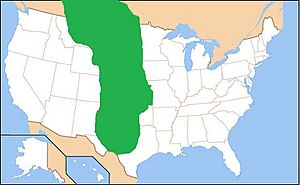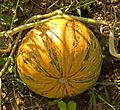Prehistoric agriculture on the Great Plains facts for kids
Long ago, before many Europeans arrived, Native American people on the Great Plains grew their own food. This area stretches across the central United States and southern Canada. They farmed from about 950 AD until the mid-1700s.
The main crops they grew were maize (corn), beans, and squash, including pumpkins. They also grew sunflowers, goosefoot, tobacco, gourds, and plums. Sometimes, these tribes would switch between farming and hunting bison (buffalo) for their food.
Contents
Farming Challenges on the Plains
Farming on the Great Plains was not always easy. The biggest challenge was that there often wasn't enough rain for crops like corn to grow well. Also, in the northern parts of the Plains, the growing season was quite short.
Because of this, farming would sometimes spread into drier areas during wet years. But it would shrink back when the weather became dry again. The number of bison also affected where people settled. Bison were a very important food source and provided skins for clothes and homes.
Early Farming History
Native Americans on the Great Plains have been gathering wild plants for food for over 13,000 years. Over time, they learned to grow or help grow useful native plants. Many plants grown in the eastern parts of North America were also grown on the Great Plains.
Squash and beans were grown in what is now the United States even before corn arrived. Corn first came from Mexico thousands of years ago and reached the United States about 1,000 years ago. Corn farming started on the Great Plains around 900 AD. This began the "Southern Plains villagers" period in Oklahoma and Texas.
These early farming communities lived in small villages along rivers like the Red, Washita, and Canadian. They got their food by both farming and hunting. Around 1000 or 1100 AD, the climate became drier. This might have made them rely more on hunting and less on farming.
Some of these early farmers, like the Antelope Creek Phase people (1200 to 1450 AD) in Texas, were influenced by the Pueblo people from New Mexico. Later, tribes like the Wichita and Pawnee continued these farming traditions.
Corn farming reached the northern Great Plains between 1000 and 1200 AD. The Missouri River Valley in North Dakota was likely the northernmost place where corn was grown before Europeans arrived.
Who Farmed on the Plains?
When European explorers first arrived, several Native American groups were farming a lot on the Great Plains.
- In the south, the Caddoan people farmed along the Red River.
- The Wichita farmed along the Arkansas River.
- The Pawnee farmed near the Kansas River and Platte River.
- Further north, the Arikara, Mandan, and Hidatsa farmed along the Missouri River in the Dakotas.
Other groups moved onto the Plains later. Some, like the Sioux and Cheyenne, stopped farming and became nomadic hunters. Others, like the Osage, Kaw, Omaha, Ponca, Otoe, Iowa, and Missouria, continued to farm while also hunting bison.
Archaeologists have even found proof that Apache people farmed in western Kansas and Nebraska in the 1600s. However, the Comanche later pushed the Apache southward off the Great Plains.
Farming Methods and Harvests
Native American farmers on the Great Plains didn't have iron tools or animals to pull plows. They mostly cleared and farmed land along rivers, especially lighter soils on raised riverbanks. These areas would flood sometimes, which helped make the soil rich again. They avoided the tough, heavy soils of the open grasslands.
Their fields were spread out along the riverbanks. Some Pawnee fields were as far as eight miles from their villages! Even with simple tools, they could grow a lot of corn. But farming on the dry Great Plains was always a bit risky.
A farming family usually needed to cultivate about two to seven acres of land each year. They would farm a field for two or three years, then let it rest for a while. This resting land, called "fallowed" land, was two to three times larger than the land they were actively farming. So, a family needed about 4 to 21 acres in total for their food. Families who hunted more needed less farming land.
Farmers could get about 10 to 20 bushels of corn from one acre. On new land, they could even get up to 40 bushels per acre! But the soil would become less fertile after a few years.
Among the Hidatsa, farmers would clear fields by burning plants, which also helped fertilize the soil. They used three main tools:
- A digging stick was a sharpened, fire-hardened stick used to loosen soil, pull weeds, and make holes for planting.
- A hoe was made from a bison or elk shoulder blade tied to a wooden handle.
- A rake was made from wood or an antler. Some women even preferred the bone hoe over iron hoes from Europeans!
Sunflowers were the first crop planted in spring, often in clumps around the edges of fields. Then, corn was planted. Native Americans often used a method called Three Sisters agriculture. They would plant about five corn seeds in a small mound of soil, with mounds about five feet apart. When the corn plants were a few inches tall, they would plant climbing beans and squash seeds between the mounds.
This system worked well:
- The large squash leaves shaded the soil, keeping it moist and stopping weeds.
- The beans added nitrogen to the soil, which helps plants grow.
- The beans also climbed up the corn stalks for support.
The Wichita people, and maybe others in the south, also planted or cared for thickets of Chickasaw Plum trees around their corn fields. Tobacco was grown in separate fields and cared for by older men. Women did most of the other farming, but men helped clear the land.
Native American farmers did not use animal manure to fertilize their fields. When the soil became less fertile, they would let the fields rest for two years before planting again.
What They Ate
Archaeologists have studied what people ate in the Medicine Creek valley in Nebraska, which was a western farming area. From 1000 to 1450 AD, their diet was about:
- 30% from game (mostly bison)
- 30% from maize (corn)
- 20% from other grown crops like squash, beans, and sunflowers
- 20% from wild plants
Further east, where there was more rain, people likely ate more of their farmed crops. The amount of farming versus hunting changed depending on how much rain the Great Plains received.
The Farming Year
The Pawnee in Nebraska were excellent farmers and had special ceremonies for planting and harvesting corn. In spring, they planted many types of crops:
- 10 kinds of corn (including flour, flint, and sweet corn)
- 7 kinds of pumpkins and squashes
- 8 kinds of beans
They knew that different corn types could mix if planted too close. So, they planted different kinds of corn in fields far apart.
Like many other Plains farmers, the Pawnee would leave their villages in late June when their corn was about knee-high. They would live in tipis and go on a summer bison hunt. They returned around September 1st to harvest their crops. Corn, beans, and pumpkins were dried, put into rawhide bags, and stored in bell-shaped pits dug underground.
After the harvest, they had a month of celebrations. In early December, they would leave their villages again for a winter hunt, with their stored food hidden underground. This yearly cycle of farming and hunting was common for Plains farmers, especially after they got horses in the late 1600s and 1700s. Horses made it easier to travel far for long hunts away from their villages.
Trading Goods
Trading between farming tribes and nomadic hunting tribes was very important on the Great Plains. The Mandan and Hidatsa villages on the Missouri River were big trading centers.
For example, in 1737, a French explorer named La Vérendrye met a group of Assiniboine people. They were planning a two-month, thousand-kilometer trip to the Mandan villages. They wanted to trade bison meat for farmed goods. There is a lot of evidence that other tribes on the Plains also traded over long distances.
Images for kids
See also
 In Spanish: Agricultura prehistórica en las Grandes Llanuras para niños
In Spanish: Agricultura prehistórica en las Grandes Llanuras para niños






